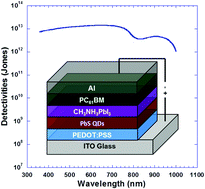Ultrasensitive solution-processed broad-band photodetectors using CH3NH3PbI3 perovskite hybrids and PbS quantum dots as light harvesters
Abstract
Sensing from ultraviolet-visible to infrared is critical for both scientific and industrial applications. In this work, we demonstrate solution-processed ultrasensitive broad-band photodetectors (PDs) utilizing organolead halide perovskite materials (CH3NH3PbI3) and PbS quantum dots (QDs) as light harvesters. Through passivating the structural defects on the surface of PbS QDs with diminutive molecular-scaled CH3NH3PbI3, both trap states in the bandgap of PbS QDs for charge carrier recombination and the leakage currents occurring at the defect sites are significantly reduced. In addition, CH3NH3PbI3 itself is an excellent light harvester in photovoltaics, which contributes a great photoresponse in the ultraviolet-visible region. Consequently, operated at room temperature, the resultant PDs show a spectral response from 375 nm to 1100 nm, with high responsivities over 300 mA W−1 and 130 mA W−1, high detectivities exceeding 1013 Jones (1 Jones = 1 cm Hz1/2 W−1) and 5 × 1012 Jones in the visible and near infrared regions, respectively. These device performance parameters are comparable to those from pristine inorganic counterparts. Thus, our results offer a facile and promising route for advancing the performance of broad-band PDs.


 Please wait while we load your content...
Please wait while we load your content...